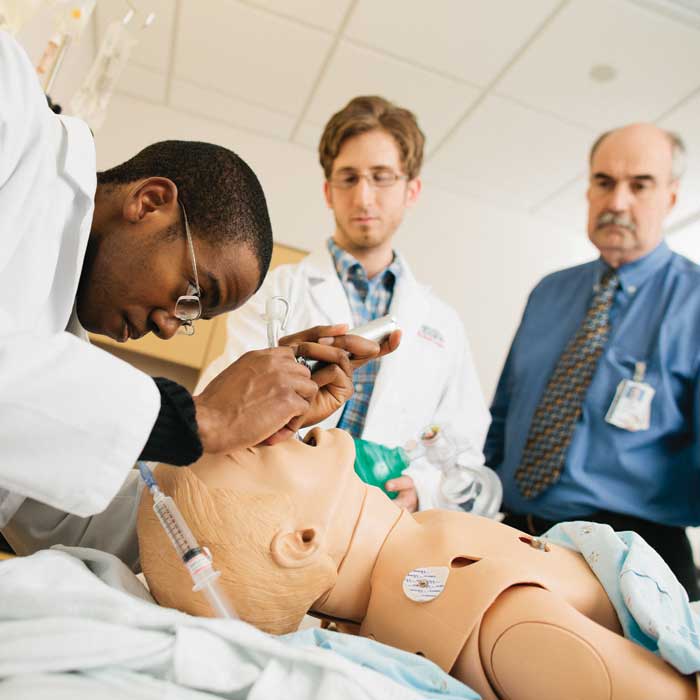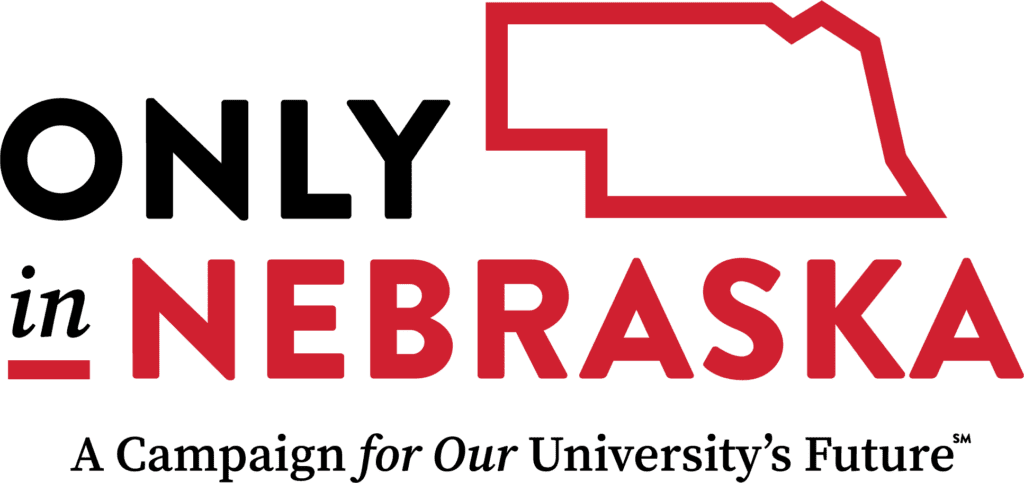High-tech equipment means better-equipped doctors


A simulation lab helps train students for real-life situations.
Mr. Jones is about to die.
Members of the rapid response team surround his hospital bed.
They’re young. They’re nervous.
They’re five UNMC medical students who will be graduating in just a few months.
“Mr., uh, Jones? Hello?”
This is their first time as a team in this critical situation. It’s not the first time for Mr. Jones, though. He’s been resuscitated at least 60 times by other UNMC students. The man – a high-tech mannequin – belongs to the Clinical Simulation Lab in the first floor of the Sorrell Center on campus.
He breathes. Or not.
Speaks. Bleeds. Urinates.
He makes lung and bowel sounds and shows symptoms of many diseases. His heart beats. Or not. He’s been programmed to die many times and in many ways.
This time, he’s had a heart attack.
“Is there a pulse?”
“No pulse.”
Within a minute, the students have started ventilating him with a plastic bag. Within a minute and 20 seconds, they’ve started chest compressions. They’re being observed by their professor and two other people who are controlling Mr. Jones from behind a window.
They’re being videotaped from two different angles.
When you do CPR, their professor, Dr. Paul Paulman, told them a few minutes before, you’re starting out with a patient who’s already dead.
You’re only going to make him better. Or not.
They deliver a shock. The shock works. Mr. Jones comes back to life.
Dr. Paulman walks into the room and applauds the students, who now all smile.
“Whew!” one says.
For years, students like these honed their skills on real patients in real situations, which carries risks. But in UNMC’s Clinical Simulation Lab, Mr. Jones and the other mannequins expect mistakes. Students gain skills and confidence more quickly.
They’re grateful for this lab, which is one of the best of its kind in the country.
“A lot of schools don’t have simulation labs like this,” says Kyle Smith, the med student who delivered the shock to Mr. Jones. “I think simulation like this is something that will be required in the future. But right now, it’s sort of on the leading edge in teaching students.
“It isn’t a substitution for real patient interaction. But I think it adds to the depth of knowledge and experience you obtain coming out of med school.”
The Clinical Simulation Lab includes a ready room, 10 large exam rooms, a hospital suite and two simulation suites. It has many mannequins that allow the students to do many things. Some mannequins have skin that “heals.” Students can draw fluids and insert needles again and again.
It has a new female mannequin, “Bertha Kidd.” She gives birth to as many as 12 babies in one hour. She can speak. And scream. Leave me alone! The baby’s coming!
Another mannequin, “Noelle,” can tell you she’s just taken cocaine.
Sometimes she speaks in Spanish.
Sometimes “Noelle’s” baby gets hung up in her pelvis – the shoulder gets stuck. In the real world, this situation – shoulder dystocia – is rare. But it’s dangerous.
Here in the lab, students practice emergencies like this over and over and so when it happens to them for real someday, at 3 in the morning, they’re more likely to remember what to do.
“They can make their errors now,” Dr. Paulman says, “not on a real mom.”
UNMC students of all disciplines use the lab. So do other schools’ students and other hospitals’ medical workers. The lab also sends out a unit – with mannequins and equipment – to rural hospitals across Nebraska to help train their workers.
“We try to keep the lab busy,” says Dr. Paulman, the lab’s director. “And we try to serve the needs of not only our campus, but the whole area.”
Another point of pride with the Clinical Simulation Lab, he says, is the real people it hires and trains to act like patients. There are still some things that Mr. Jones and Bertha and the other non-humans can’t do, like communicate non-verbally.
“We’re very proud of this place,” he says. “We think it’s kind of pushing the envelope.”
Very few medical schools, he says, have such a high-tech simulation lab.
The lab soon will become even better.
Thanks to a donor’s generous gift, the lab will be remodeled and expanded with the addition of a surgical simulation suite. The new suite should be finished next year. The suite will include virtual-reality technology and even more high-tech mannequins. It will train many future surgeons and emergency room doctors and nurses, many of whom will stay in the state.
Clinical skills testing is a fairly new addition to the National Board exams that med students must pass.
Kyle, who hopes to become a neurosurgeon, says UNMC’s simulation lab definitely helped him do well on that portion of the test.
“It’s a privilege,” he says, “to be at a place that’s on the foreground of getting this out there, getting this integrated into education.”
Dr. Paulman plays the video for the students. Some groan as they see their mistakes unfold.
They should have taken away the pillow, to help with ventilation. One student noticed how she at first had asked for the drug epinephrine in “grams” before correcting it to “milligrams.”
“I thought you guys functioned well, coming together for the first time in a critical, high-adrenalin situation,” Dr. Paulman says. “The purpose is not to do this perfectly. Nobody has. Nobody can.
“We want to see errors that happen now and improve them the next time.”
And a few minutes later, it happens again.
Mr. Jones dies.
He has another cardiac arrest.
This time, looking much less nervous, the five future doctors rush to his side.
Student support is one of the top priorities of the campaign. If you’d like to help students like these future doctors, please consider giving online or contact the foundation at 800-432-3216.





